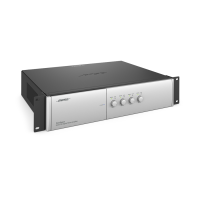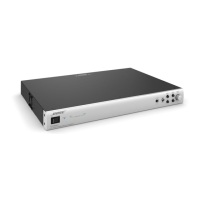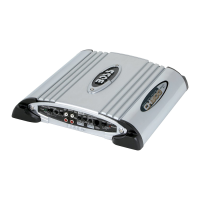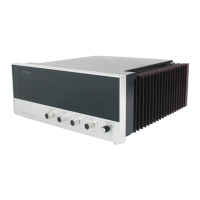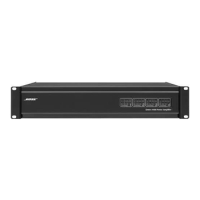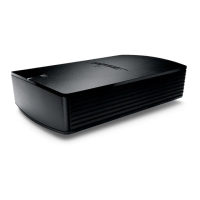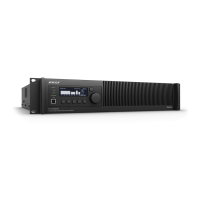52
TEST PROCEDURES
4.6 Measure the distortion level at the left
channel output. Harmonic distortion should
be < 0.5% (20 Hz to 20 kHz bandwidth).
4.7 Repeat steps 4.2 through 4.6 for the
right channel.
5. High Pass Filter Frequency Response
5.1 On the amplifier front panel, set the left
and right channel gain controls fully CW.
On the rear panel, set the configuration dip
switches (7) to ON HP and 80 Hz.
5.2 Connect a 4 Ohm load resistor to the left
and right channel 4 Ohm speaker outputs.
5.3 Apply a 400 mVrms, 1 kHz signal to the
left channel input.
5.4 Reference a dB meter to the left channel
output level. This is the 0 dB reference level.
5.5 Change the signal generator frequency
to 80 Hz. Measure the left channel output
level. It should be -3.0 dB + 0.5 dB.
5.6 On the amplifier rear panel, change the
configuration dip switches (7) to ON HP and
120 Hz.
5.7 Change the signal generator frequency
to 120 Hz. Measure the left channel output
level. It should be -3.0 dB + 0.5 dB.
5.8 Repeat steps 5.3 to 5.7 for the right
channel.
6. FX Loop Test
6.1 On the front panel of the amplifier, set the
gain controls fully CW. On the rear panel, set
the configuration dip switches (7) OFF
(down).
6.2 Connect a 4 Ohm load resistor to the left
and right channel 4 Ohm speaker outputs.
6.3 Apply a 100 mVrms, 1 kHz signal to the
amplifier left channel input.
6.4 Using a DMM, check the FX SEND
terminals for a 100 mV + 2.6 mV output level.
6.5 Jumper the SEND outputs into the
RECV inputs. On the rear panel, set the
configuration dip switches (7) to IN FX.
6.6 Measure the output level at the left
channel outputs. It should be 3.01 V + 0.14V.
6.7 Repeat steps 6.3 to 6.6 for the right
channel. Reset the configuration switches to
OUT FX after the completion of these tests.
7. Level Controls Test
7.1 On the front panel of the amplifier, set
the gain controls fully CW. On the rear panel,
set the configuration dip switches (7) OFF
(down).
7.2 Connect a 4 Ohm load resistor to the left
and right channel 4 Ohm speaker outputs.
Remove any connections to the remote level
input.
7.3 Apply a 775 mVrms, 1 kHz signal to the
left channel input. Reference a dB meter to
the left channel output level. This is the 0 dB
reference level.
7.4 Set the left channel level control to
midpoint, nominally the 21st of the 41
mechanical detents.
7.5 Measure the left channel output level.
It should be -50 dB + 5.0 dB.
7.6 Repeat steps 7.3 to 7.5 for the right
channel.
8. Remote Level Control Test
8.1 On the front panel of the amplifier, set
the gain controls fully CW. On the rear panel,
set the configuration dip switches (7) OFF
(down).
8.2 Connect a 4 Ohm load resistor to the left
and right channel 4 Ohm speaker outputs.

